
|   |

|   |
 e-mail: ukb7@rediffmail.com The political spectra November 10, 2018 If the historical curtain could open on the turning point of the first Christian millennium's end, one would accost the loose "confederacy" of Baro Bhuyan (Twelve Landlords) as a relic of the erstwhile Kamarupa kingdom that covered all of Assam, North Bengal and large portions of Bangladesh. When eventually the central Kamarupa kingdom fragmented, the system of small chieftains remained. In Bengal as in Assam, the Baro Bhuyans were found in regions within the traditional boundaries of the erstwhile large kingdom.The more prosperous ones gave themselves the epithet of Raja (the King). In times of aggression by external powers, they generally cooperated in defending and expelling the aggressor. In times of peace, they maintained their respective sovereignty. In the presence of a strong king, they offered their allegiance. Sonai Bibi presented on September 30 by Rongroop in Kolkata, used this historical scenario as its overall backdrop. The story, originally penned by the iconic litterateur Sunil Gangopadhyay, was dramatized by Sounava Basu situating the play's events at a time when the Mughal dynasty was in the ascendant in the subcontinent, with Emperor Akbar planning a foray into the Eastern territories under the leadership of his brave Rajput general Man Singh in order to claim a Mughal suzerainty. 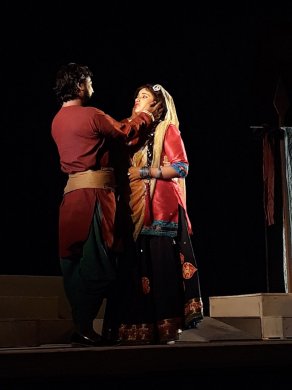
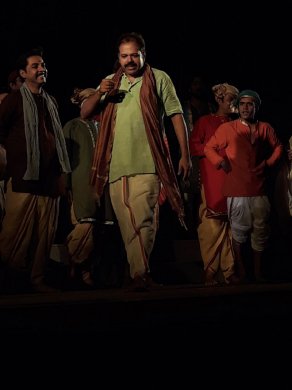
Sonai Bibi
Directed by Jayanta Mitra (and guided by Sima Mukhopadhyay), Sonai
Bibi's charm is not only its historical authenticity -- which could
indeed have been pushed to a figurative background and not depicted in a
tearing hurry -- but also the illumined focus it kept strongly riveted
on the stark wilderness of the rural countryside. There the palanquin of
hapless Hindu widow, Swarnamayee, of a royal family -- from Raja
Pratapaditya's household in Tripura - is set upon by dacoits in
disguise. Just when her modesty was at stake, she is rescued by an
intrepid stranger, the Bhuyan Isha Khan. Their close encounter of the
romantic kind suddenly leaves a thousand questions -- of shackles of
widowhood and the widow's bondage of never marrying again (unlike such
liberty permitted in Islam) -- unresolved, haunting young Isha Khan's
mind. Unlike the traditional annals of Laila-Majnu, Soni-Mahiwal, Dhola-Maru and Sirin-Farhad, the Swarnamayee-Isha Khan affair is cast on a far-reaching feudal and political significance - rather invoking nuances of Romeo-Juliet of the English Bard - and has to be seen and analysed in that light. So, when the duo meets again and, after a beautifully nuanced conversation between the two, they begin their new sojourn together, the Hindu widow's family, tradition and heritage are left aside; and the youthful Muslim chieftain picks up shreds of a dream, putting the image of his intense mohabbat on the pedestal of a grand Hindu-Muslim unity in fighting back the Mughal aggression in the East. Isha Khan stakes his life to no avail and now the transformed 'Sonia Bibi' - in her avatar as a sword wielding rabble rouser - fights a losing battle against Mughals, without realising her dead beloved's cherished vision of a communal unity. The play transcends a mere love story and works very well in confronting multiple questions: from personal existential freedom, to communal freedom, convoluted politics of religion, and the hidden narrow-mindedness of fundamentalism in each individual, in the seething cauldron of an undivided Bengal. Isha Khan, Sonai Bibi and, indeed, all others gave a good account of themselves in ensemble acting in a stylised framework, with excellent props and lighting effects. 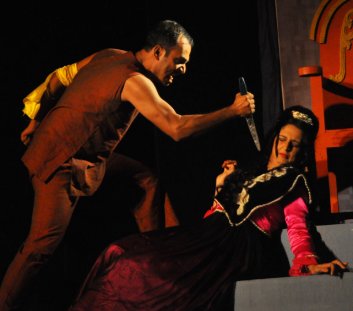
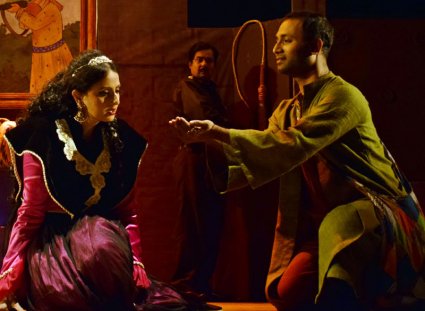
Singhasoner Kshayroag
The second play (whose sarcastic title means 'The Degenerating Throne')
presented on October10 by Nandimukh in Kolkata and directed by Ashok
Chattopadhyay, was an out-and-out political parable. Its celebrated
playwright Mohit Chattopadhyay -recognised as a superb craftsman of
poetic theatre in India --- located his mid 1960's play, with its very
symbolic narrative, in the confinement of an imaginary fortress which
saw the autocratic authority of the Queen surrounded by her henchmen.
The gun-wielding portrait of the dead king on the cyclorama, with his
trophy of a fierce tiger's mounted head in front, implied a streak of
ruthlessness embodied by the Queen holding her minions in utter
thraldom. Enacted spiritedly by Alokparna Guha, the Queen - attired in
an unwieldy Western maxi -- was conspiratorially alluded to as "a
surviving spirit, a walking dream" by the Commander of the Fort (enacted
tersely by the director himself) to instil awe among the henchmen
comprising a vain glorious General (in a military uniform), a
profusely-bearded Scientist (in an outlandish jacket), a rituals
mumbling Priest and an ever anxious Journalist, talking incessantly
about his next day scoop. Evidently, these characters were meant as caricatures, rather than real flesh-and-blood ones, fawning on their Queen. Among others, Jiban Lal, the common drummer and his flame Chitralekha, the Queen's maid-in-waiting, together, set the play's opening with their revelry as well as marked the play's closure by their joyful song of freedom. In this mise-en-scene also floated in the Painter initially seen as the Queen's foil but later as her alter ego. He was retained by her to draw pictures of the outside orchard under auction, then disappearing from sight (yet actually hiding within the fortress with the Queen's connivance), even attempting on the Queen's life with a deadly dagger; and eventually fleeing the sieged fort along with the Queen as a lover-duo. All the while, there was rumbling noise of the outside crowd -heard through the fort's protected apertures - who demanded liberation of the fort, orchard and all. Samik Bandyopadhyay, a seasoned commentator, avers on the highly figurative action in the drama: "The ruling class plays with power, passion and intrigues in strange combinations, but has to bury their own divides, dissentions and distrust to make a safe escape from the victorious commoners who would not let the master class get away..." On the play's motif, he adds, "It was the case of concentration of state power and its torchbearers inside a Middle-Age fort-palace versus the rise in revolt of the people's power outside, leading to the former's inevitable downfall in the hands of the latter..." 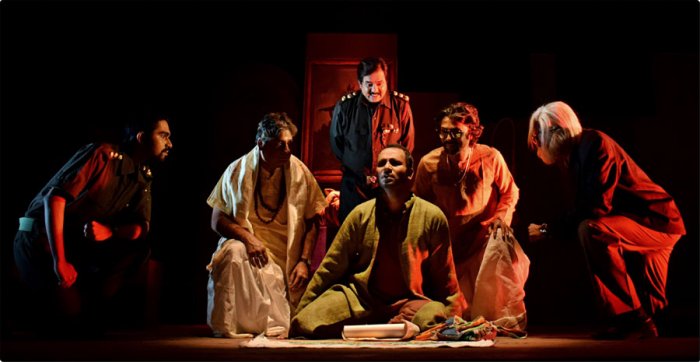 Singhasoner Kshayroag The most obvious connect of this play, to this critic, seems to its illustrious predecessor Red Oleanders penned by Tagore in 1924. The latter's play "raises the fundamental issue of the free life set against the most terrible machinery of a highly organised society... the age-old struggle between the individual and the state", as opined by Krishna Kripalani in his biography of Tagore, which is mirrored by Mohit in the clash between the ruling class and the commoners, mentioned above. The head of the ruling hierarchy in Tagore, namely, the gold-amassing King of Yakshapuri, and his bÍte noire, the flower-girl Nandini, are played in the reverse gear here: as the power-hungry Queen and the desperately gambling visual artiste Chitrakar who, however, make a common cause at the end, as in Tagore. The latter's Yaksha King is assisted by a number of functionaries -- like the menacing Sardar, his fierce associates, the pliable priest and the pedantic professor - who are all neatly replicated in Mohit's play. The emancipators in Tagore like Kishor, Fagulal, his wife, et al., are here present succinctly as Jiban Lal and Chitralekha. Even Yaksha King's epic solo lamentation on his existential fears is echoed here in the Queen's solitary monologue on her very private distress (splendidly delivered by Alokparna). The only character, missing in Mohit, appears to be the inspirational Ranjan, whose sacrifice paved the blood-soaked way of the commoners' success in Tagore's classic vision. Otherwise, Mohit has taken off from the grand imagery of Tagore - to create a very similar poetic allegory on our own distressful, fractured times, brought to public by Nandipat in a well-mounted play, for which they deserve our gratitude.  Dr. Utpal K Banerjee is a scholar-commentator on performing arts over last four decades. He has authored 23 books on Indian art and culture, and 10 on Tagore studies. He served IGNCA as National Project Director, was a Tagore Research Scholar and is recipient of Padma Shri. Post your comments Please provide your name and email id when you use the Anonymous profile in the blog to post a comment. All appropriate comments posted with name & email id in the blog will also be featured in the site. |